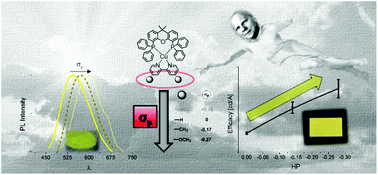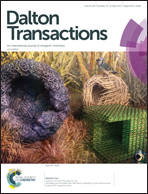σ-Hammett parameter: a strategy to enhance both photo- and electro-luminescence features of heteroleptic copper(i) complexes†
Abstract
This work studies the effect of the σ-Hammett parameter (σp) – i.e., the σ-donation effect caused by substitution at the para position of a bipyridine ligand (4,4′-R2bipy, where R is MeO, Me, H, NO2) – on both the photo- and electro-luminescence features of a series of heteroleptic copper(I) complexes – i.e., [Cu(N^N)(P^P)]+ where N^N and P^P ligands are R2bipy and Xantphos, respectively. By virtue of a comprehensive photophysical, theoretical, and thin-film lighting device – i.e., light-emitting electrochemical cells (LECs) – investigation, we note a clear relationship between the σp and the photo- and electro-luminescence parameters, such as photoluminescence quantum yields, excited-state lifetimes, and emission maxima, as well as device brightness, stability, and efficacy, respectively. As the most relevant finding, the substitution with the group featuring the most negative σp – i.e., MeO – provides a ca. five-fold enhancement of all of the aforementioned figures-of-merit upon comparison within the series of complexes. As such, this work provides a new guideline for a device optimization through a rational ligand design for heteroleptic copper(I) complexes.



 Please wait while we load your content...
Please wait while we load your content...